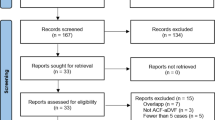Abstract
To date, intracranial aneurysms have been reported in two patients with Noonan syndrome. We report two unrelated patients with Noonan syndrome who presented with sub-arachnoid haemorrhage secondary to intracranial aneurysms. These cases are discussed and other cerebrovascular abnormalities that have been described in association with Noonan syndrome are reviewed. Ultrastructural and genetic factors contributing to these associations are considered.


Similar content being viewed by others
References
Taybi H (1996) Noonan syndrome. In: Taybi H, Lachman RS (eds) Radiology of syndromes, metabolic disorders and skeletal dysplasias, 4th edn. Mosby, St. Louis, pp 352–355
Collins E, Turner G (1973) The Noonan syndrome. J Paediatr 83:941–950
Ranke MB, Heidemann P, Knupfer C, Enders H, Smaltz AA, Bierich JR (1988) Noonan syndrome: growth and clinical manifestations. Eur J Pediatr 148:220–227
International subarachnoid aneurysm trial (ISAT) collaborative group (2002) International subarachnoid aneurysm trial (ISAT) of neurosurgical clipping versus endovascular coiling in 2143 patients with ruptured intracranial aneurysms: a randomised trial. Lancet 360:1267–1274
McAnena O, Padilla JR, Buckley TF (1984) Intracranial aneurysm in association with Noonan’s syndrome. Ir Med J 77:140–141
Hara T, Sasaki T, Miyauchi H, Takakura K (1993) Noonan phenotype associated with intracerebral hemorrhage and cerebrovascular anomalies: case report. Surg Neurol 39:31–36
Bingham WF (1977) Treatment of mycotic intracranial aneurysms. J Neurosurg 46:428–437
Tanaka Y, Masuno M, Iwamoto H et al. (1999) Noonan syndrome and cavernous hemangioma of the brain. Am J Med Genet 82:212–214
Schon F, Bowler J, Baraister M (1992) Cerebral arteriovenous malformation in Noonan’s syndrome. Postgrad Med J 68:37–40
Pandolfi C, Rosatelli T, Tarocchi A, Bianchi C, Dugnani D (2001) Sindrome di Noonan associata ad emorragia cerebrale. Descrizione di un caso. Ann Ital Med Int 16:54–58
Sharland M, Paton MA, Talbot S, Chitolie A, Bevan DH (1992) Coagulation factor deficiencies and abnormal bleeding in Noonan syndrome. Lancet 339:19–21
Wilms H, Neubacher B, Deuschl G, Zunker P (2002) Cerebral occlusive artery disease in Noonan syndrome. Cerebrovasc Dis 14:133–135
Hinnant CA (1995) Noonan syndrome associated with thromboembolic brain infarcts and posterior circulation abnormalities. Am J Med Genet 56:241–244
Robertson S, Tsang B, Aftimos S (1997) Cerebral infarction in Noonan syndrome. Am J Med Genet 71:111–114
Tang KT, Yang W, Wong J, Lee KY (1999) Noonan syndrome associated with moyamoya disease: report of one case. Acta Paediatr 40:274–276
Ganesan V, Kirkham FJ (1997) Noonan syndrome and moyamoya. Pediatr Neurol 16:256–258
Schuster JM, Roberts TS (1999) Symptomatic moyamoya disease and aortic coarctation in a patient with Noonan syndrome: strategies for management. Pediatr Neurosurg 30:206–210
Ishiguro Y, Kubota T, Takenaka J et al. (2002) Cardio-facio-cutaneous syndrome and moyamoya syndrome. Brain Dev 24:245–249
Ion A, Tartaglia M, Song X et al. (2002) Absence of PTPN11 mutations in 28 cases of cardiofaciocutaneous syndrome. Hum Genet 111:421–427
Rauen KA, Cotter PD, Bitts SM, Cox VA, Golabi M (2000) Cardio-facio-cutaneous syndrome phenotype in an individual with an interstitial deletion of 12q: identification of a candidate region for CFC syndrome. Am J Med Genet 93:219–222
Ajimi Y, Uchida K, Kawase T, Toya S (1992) A case of Turner syndrome associated with moyamoya disease. No Shinkei Geka 20:1021–1024
Bolton MR, Pugh DM, Mattioli LF, Dunn MI, Schimke RN (1974) The Noonan syndrome: a family study. Ann Intern Med 80:626–629
Au YK, Patrick WP, Patel JS, Asamoah A (1997) Spontaneous corneal rupture in Noonan syndrome. Ophthalmic Genet 18:39–41
Maheshwari M, Belmont J, Fernbach S et al. (2002) PTPN 11 mutations in Noonan syndrome type 1: detection of recurrent mutations in exon s 3 and 13. Hum Mutat 20:298–304
Tartaglia M, Mehler E, Goldberg R et al. (2001) Mutations in PTPN11, encoding the protein tyrosine phosphatase SHP-2, cause Noonan syndrome. Nat Genet 29:465–468
Chen B, Bronson RT, Klaman LD et al. (2000) Mice mutant for Egfr and Shp-2 have defective cardiac semilunar valvulogenesis. Nature Genet 24:296–299
Schievink WI (1997) Genetics of intracranial aneurysms. Neurosurgery 40:651–663
Carmeliet P (2000) Mechanisms of angiogenesis and arteriogenesis. Nat Med 6:389–395
Oyama H, Nakane T, Handa T et al. (1998) Two cases of subarachnoid hemorrhage associated with neurofibromatosis type 1: a case of multiple cerebral aneurysms and arteriovenous malformation, and another case of an anterior communicating artery aneurysm. No Shinkei Geka 26:151–156
Conway JE, Hutchins GM, Tamargo RJ (2001) Lack of evidence for an association between neurofibromatosis type 1 and intracranial aneurysms: autopsy study and review of the literature. Stroke 32:2481–2485
Kawamura K, Jono M, Klatsuragi M, Baba S, Shida K (1994) A case of neurofibromatosis with occlusion of multiple cerebral artery, moyamoya phenomenon and scoliosis. No To Shinkei 46:1163–1168
Sobata E, Ohkuma H, Suzuki S (1988) Cerebrovascular disorders associated with von Recklinghausen’s neurofibromatosis: a case report. Neurosurgery 22:544–549
Author information
Authors and Affiliations
Corresponding author
Rights and permissions
About this article
Cite this article
Dineen, R.A., Lenthall, R.K. Aneurysmal sub-arachnoid haemorrhage in patients with Noonan syndrome: a report of two cases and review of neurovascular presentations in this syndrome. Neuroradiology 46, 301–305 (2004). https://doi.org/10.1007/s00234-004-1185-3
Received:
Accepted:
Published:
Issue Date:
DOI: https://doi.org/10.1007/s00234-004-1185-3




